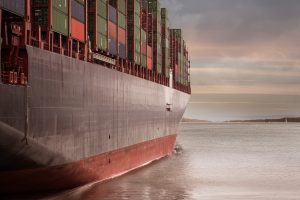Maritime transport is the most suitable way of transport of all consignments where the priority is to save transport costs and your goods are not in a hurry to reach the destination. If you have got an express consignment, it is better to choose another type of transport in most cases (e. g. air transport).
We arrange transport from/to all overseas ports and follow-up complete service including reloading, issuing transit documents and subsequent transport from/to the inland. Besides, we offer additional services such as insurance against transport risks, custom services, storage etc. We will arrange a “door to door” service for you with selected partner networks around the world.
We specialize in the types of maritime transport mentioned below.
Maritime Container Transport (FCL = Full Container Load)

is used for a greater volume of goods. The container is loaded and unloaded at risk and account of one single consignor and only one consignee. In practice, it means that the whole container is meant for one consignee and the consignor is responsible for loading, load (arrangement of goods in the container), fixing the container, quantity, weight, and content of the consignment. ISO containers series 1, the most common universal or standard containers are used for the carriage.
Benefits of ISO containers:
- The risk of loss of the shipping goods is minimal
- The construction enables easy loading and unloading
- Transferring of goods is not necessary (reducing the energy consumption during transshipment, reduction of possible damage of goods)
- The construction enables multiple stacking
- They are easy to manipulate
The container is fully closed, waterproof and weatherproof. The goods in the maritime container are secured with the same seal throughout the whole route, from the place of dispatch to the consignee’s place of unloading. Containers are intended for intercontinental, international and domestic combined transport (maritime, river, rail and road).
Maritime transport is suitable for goods of non-standard dimensions, too. We also arrange carriage in non-standard containers. For example, 45’ containers for bulky goods, refrigerated containers for the carriage of goods requiring thermoregulation, open-top containers with tilts instead of a solid roof, Plato containers or containers with heads designed to carry oversized loads. The price is always calculated per container or, in the case of oversize consignments, per other container places, in which they interfere with their volume.
When shipping container consignments, you can encounter the abbreviation TEU (Twenty-foot Equivalent Unit), an equivalent of standardized 20-foot containers. So, 20’ container = 1TEU and 40’ container = 2TEU. Maximum of 10 euro pallets (length 120 cm x width 80 cm) fit in the floor of the 20’ container.
Maritime container groupage (LCL = Less than Container Load)
is intended for smaller consignments. So, the volume of goods is not great enough to infill the whole container effectively. In this case, the container is loaded with other units of consignments. Due to the effective use of space, the total price of carriage divided among all the participants by calculating the price according to the volume that each consignment takes in the groupage container. We arrange the carriage of units of consignments in the groupage containers in cooperation with our partners in ports and inland transshipment points.
Carriage of cars on own axis (RO-RO)
on roll-on/roll-off ships. It is a type of cargo ship intended for direct loading and unloading of consignments on road and rail underframes or vehicles that drive onto (roll-on) and out (roll-off) of the ship on their axis.
